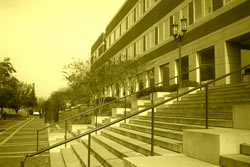|
November 5th: Color, Color, Color
It Turns Me Upside Down
Color, Color, Color
It's Like a Merry-Go-Round
...Color is Magic!
Plan for the Day
We've got a few things to do today, so below is a list:
Also, many students start to get sick this time of year. If you're coughing, sniffling, or blowing your nose constantly, please reconsider if you're able to participate in class tonight. Not only is coughing distracting, but it spreads germs!
Perception, Culture, Rhetoric
Color perception is an interesting subject that deals with physiological responses. While I don't expect you to be well versed in the anatomy of the eye, there are several terms you should know:
- visible spectrum (p. 248): "a small range of wavelengths between 700 and 400 nanometers (nm)" in which humans can perceive light.
- hue (p. 249): wavelengths of light that cause us to perceive different colors.
- saturation (p. 250):
perception of the purity of color.
- unsaturation (p. 250): a mixture of colors.
- brightness (p. 250): perception of the intensity of light that is transmitted or reflected from a surface.
- tristimulus (p. 249): human perception of colors based on the mixture of perception of the three types of cones in the eye, red, green, and blue.
- ganglion cells (p. 249): the nerves that help distinguish between colors.
- additive primary colors (p. 250): red, green, and blue.
- cyan...it's not the pepper; pronounced cy-an.
- complementary colors (p. 250): two colors directly opposite from each other on the 360-degree color wheel.
- analogous colors (p. 250): "colors close together on the same wheel."
- Color Temperature (p. 251): obviously, this is related to our feelings associated with various colors.
- warm colors: colors naturally brighter at the same level of saturation (i.e. red and yellow).
- cool colors: colors not as bright as warm colors at the same saturation (i.e. green and blue).
- color vision deficiency (p. 252): limitation in perceiving color differences.
Color and time period...we already mentioned that orange, brown, and burnt sienna are colors of the 1970s. What about predominant colors of the following decades:
- 1960s
- 1970s
- 1980s (early and late)
- 1990s--the last great decade...EVER!
Matching Colors
I know this is a peculiarity of mine, but color matching is really ingrained racism of a culture. Let me explain...
Ethics and Visuals
Let's jump back to last week's "stuff" if there's time.
Photoshop And Mischievous Behavior
Don't forget to do a little digital graffiti if you didn't finish last week. Use the "Clone Stamp Tool" or, if that's beneath you, try out the lasso tool.
This assignments are part of your Web page grade, so please don't put up anything that will embarrass you...or me!
Tutorial or Brochure Workshop
Let's get to it! You know the drill by now. We'll start at 8:30 pm...even if you're still talking about tonight's reading.
Next Week
Make sure you read
Ch. 7 in the Non-Designer's Design Book will be for Nov. 12th. Both chapters discuss color. In your planning memos, I want you to explain your reasons for choosing colors. Don't just state what a color means based off some out-of-context web page or your own "tastes." Instead, you should let me know why a color means what it does. There are several interpretations possible.
- Why is blue calming?
- Why is yellow for sickness?
- Exceptions: Green for environmental stuff and Red for danger or love...those are pretty common, but state that your purpose for choosing them.
Those of you who haven't turned in these portfolio assignments will definitely want to get them to me ASAP.
...
|
